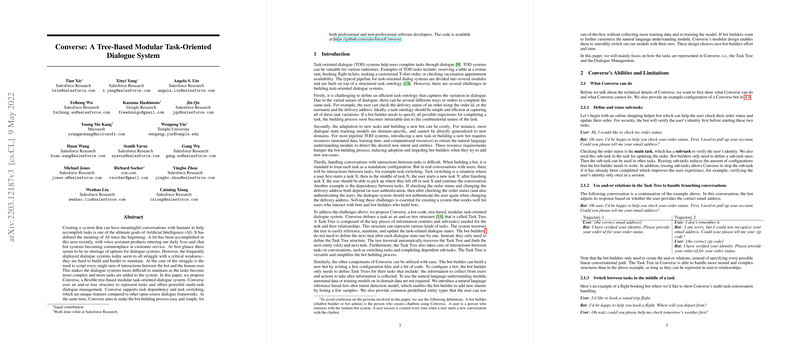An Examination of Converse: A Tree-Based Modular Task-Oriented Dialogue System
The paper presents Converse, a flexible and low-code tree-based modular task-oriented dialogue system, proposing a novel approach to managing task-oriented dialogues through an and-or tree structure. This system is designed to handle multiple tasks seamlessly, offering a potentially significant advancement in how modular dialogue systems are constructed and operated.
Summary of Converse
Converse addresses the inherent complexity in building and maintaining task-oriented dialogue systems. Traditional dialogue systems require extensive scripting for each interaction, leading to increased difficulty in managing multiple and complex tasks. In contrast, Converse introduces a modular approach using an and-or tree structure called the Task Tree. This structure simplifies the bot-building process by allowing developers to define high-level tasks as combinations of sub-tasks and their dependencies using logical and/or relationships.
Technical Contributions
Converse stands out due to several capabilities:
- Task Representation: Tasks are represented as and-or trees, which encapsulate task-related information and dependencies logically and intuitively.
- Multi-tasking and Task Switching: The system supports switching between tasks and managing task dependencies during interactions. This capability allows for the simultaneous management of multiple tasks without human intervention.
- Simplified Bot Configuration: Developers can construct new bots with minimal configuration by defining Task Trees and utilizing the system's default dialogue policies and natural language understanding (NLU) capabilities.
Numerical Results and Claims
While the paper does not present extensive experimental results or quantitative analysis that are often critical in system evaluation, it emphasizes system flexibility and ease of task configuration as qualitative benefits. The claims focus on the reduced effort required to develop task-oriented dialogue bots and the intuitive handling of task dependencies and switching.
Limitations and Future Work
The paper clearly outlines the limitations of Converse. Notably, it lacks multilingual support and cannot explicitly cancel ongoing tasks. Furthermore, the system's natural language generation (NLG) relies on template-based methods, restricting open-domain conversational capabilities. Despite these constraints, Converse offers a promising framework that can be expanded upon.
Discussed future work includes the integration of advanced NLU and dialogue policies, such as dialogue act classification and open-domain dialogues. These enhancements could significantly improve the flexibility and functionality of Converse, aligning it more closely with the demands of modern conversational AI applications.
Theoretical and Practical Implications
Theoretically, Converse's tree-based modular architecture may simplify the conceptual complexity involved in managing dialogue systems, allowing for easier scalability and adaptability. Practically, the low-code requirement for bot configuration could facilitate broader adoption across industries, especially for enterprises seeking cost-effective and easily maintainable dialogue systems. Moreover, the system's modular nature enables the integration of custom NLU and NLG models, providing opportunities for tailored solutions.
The modular paradigm presented in Converse opens avenues for further developments in AI dialogue systems. Research into more sophisticated task representations and dynamic dialogue management strategies could lead to systems that better emulate human-like conversation capabilities.
Conclusion
The paper offers a compelling method for constructing task-oriented dialogue systems through Converse's innovative use of task trees. Despite some limitations, the modularity, ease of use, and adaptability of Converse make it an interesting contribution to the field of dialogue systems. As AI continues to evolve, such systems will become increasingly crucial in building responsive, efficient, and user-friendly conversational agents.
